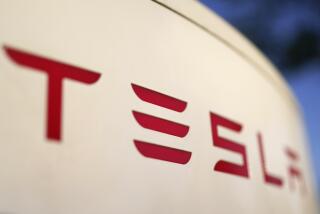Toyota’s Camry, Prius v beaten up in crash test [slow-mo video]
Two key Toyota models, the flagship Camry sedan and the Prius v wagon, failed an important new crash test conducted by the Insurance Institute for Highway Safety, an insurance industry group.
Honda’s newly redesigned Accord tied for the top safety rating with the Suzuki Kizashi, a car that will soon no longer be sold in the United States. The redesigned Ford Fusion also scored well.
The results raise concerns that the Toyota models can’t provide protection from serious injuries in common accidents. The automaker’s new Prius v, a wagon version of the popular hybrid, scored last among 18 cars tested, with “poor” ratings in five of seven categories. The Camry -- America’s bestselling passenger car -- scored next to last.
“Toyota engineers have a lot of work to do to match the performance of their competitors,” said Adrian Lund, the insurance group’s president.
PHOTOS: Popular cars’ crash test ratings
Toyota, in a statement, vowed to focus on improving safety.
“With this new test, the institute has raised the bar again, and we will respond to the challenge,” the automaker said.
Toyota said the Camry and Prius v have performed well on other tests and are still rated as “Top Safety Picks” by the organization.
The new test -- in which 25% of a car’s front end on the driver’s side strikes a 5-foot-tall rigid barrier at 40 mph -- simulates a wreck in which the front corner of the car hits another car or a solid object. This was the first test of family cars and follows a similar test this year in which only three of 11 luxury cars scored well.
The front corner crashes can be particularly severe. “The crash damage in these tests is like the damage we see in real-world crashes where heads and chests are injured,” Lund said.
The trade group said some automakers, including Honda, Ford and Nissan, are starting to redesign vehicles to protect passengers in front-corner impacts, and that’s one of the reasons the family cars fared better than luxury cars.
But Toyota has work to do. The institute found multiple intrusions, including the front driver’s-side wheel, of various components into the passenger cabins of both vehicles.
“The Camry’s driver airbag and side curtain airbag deployed, but the steering wheel moved so far to the right that the dummy’s head made only minimal contact with the front airbag. The side curtain airbag didn’t extend far enough forward to help prevent the dummy’s head from hitting the instrument panel,” the institute said in its report. “In the Prius v, the side curtain airbag deployed too late in the crash to offer protection.”
The Accord, by contrast, earned “good” ratings in five out of six categories in the test and overall. In the test, the Accord’s safety belts and airbags worked together to provide protection, the institute said.
The car’s structure held up better, enabling the driver airbag to cushion the dummy’s head and chest. The side curtain airbag extended far enough forward to prevent the dummy’s head from hitting interior components, the institute said.
Honda added high-strength steel to the Accord to prevent cabin intrusion in such crashes, said Chuck Thomas, the automaker’s chief engineer for automotive safety research. It also designed the car to more quickly absorb forces to improve passenger safety, he said.
The institute first started publishing data on these kinds of crashes in 2009, giving Honda time to research the issue and make improvements to the Accord, he said.
“Safety is something that customers think about particularly in buying vehicles in the mid-size sedan segment,” Thomas said. “These are cars that families use and drive every day.”
Consumers should take note of safety tests conducted by the organization, said Jake Fisher, automotive test director for Consumer Reports. Consumer Reports will withhold a recommendation if a vehicle performs poorly in some of the older, key tests performed by the organization.
“Over time, their tests have become more stringent than the government tests, and they tend to push further,” Fisher said. “That keeps the manufacturers building safer cars.”
ALSO:
Shattering sunroofs prompt Veloster recall
GM to buy back stock from Treasury as U.S. plans bailout exit







